1weaving
Weaving was already multimedia: Weavers & needleworkers were literally networkers.
Weaving practices date back to 20.000 B.C.. The earliest manufactured threads were multipurpose materials used for carrying, holding, tying, trapping. Paper was back then made from dense natural fibers that were assembled through weaving. Papyrus uses the same flax from which linen was later produced. Textures and textiles functioned as communication and information storage, way before letter sytems were introduced.
The Computer emerges out of the history of weaving, the process so often said to be the quintessence of women’s work. The loom is the vanguard site of software development [1].
Long before Ada Lovelace, women have been associated with software. Psychoanalysis founder Sigmund Freud describes weaving as imitation of the wombs concealed characteristics. Weaving is seen as compensation for the absence of penis, as practice to fill the void, which is inherent to a womens sex [2].
Computer has two separate yet related meanings. A computer, from the early 17th century and up until the first half of the 20th century, referred to “someone who computes.” It was a person whom, by hand, performed time-consuming and tedious mathematical calculations. As the work of such Computers was akin to secretarial work, it was often the work of women [3].
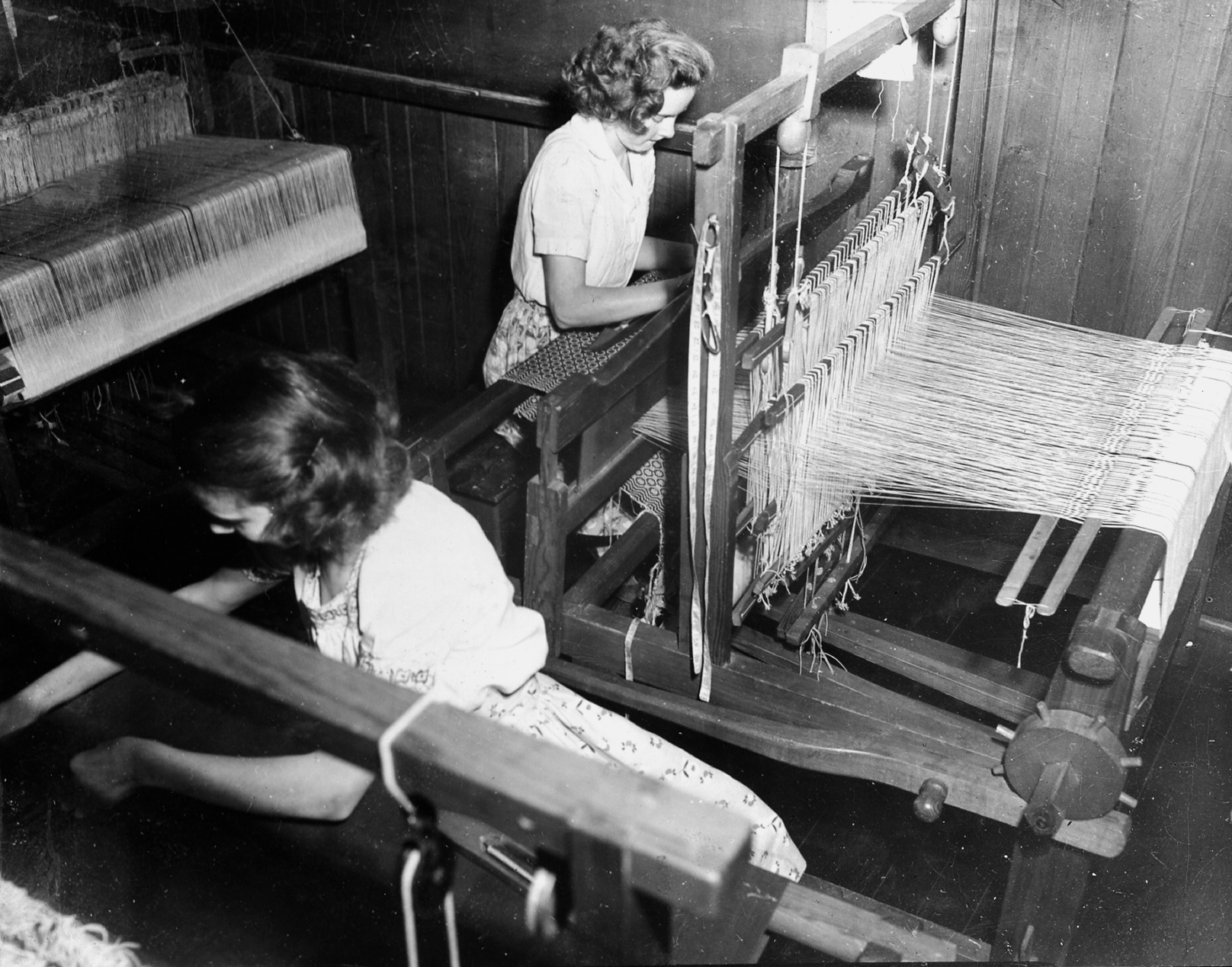
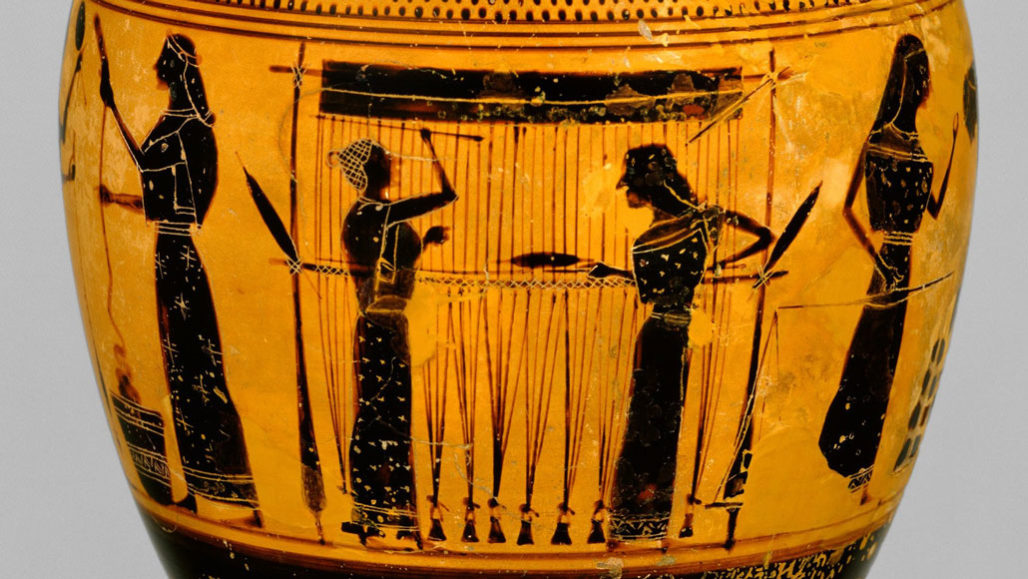
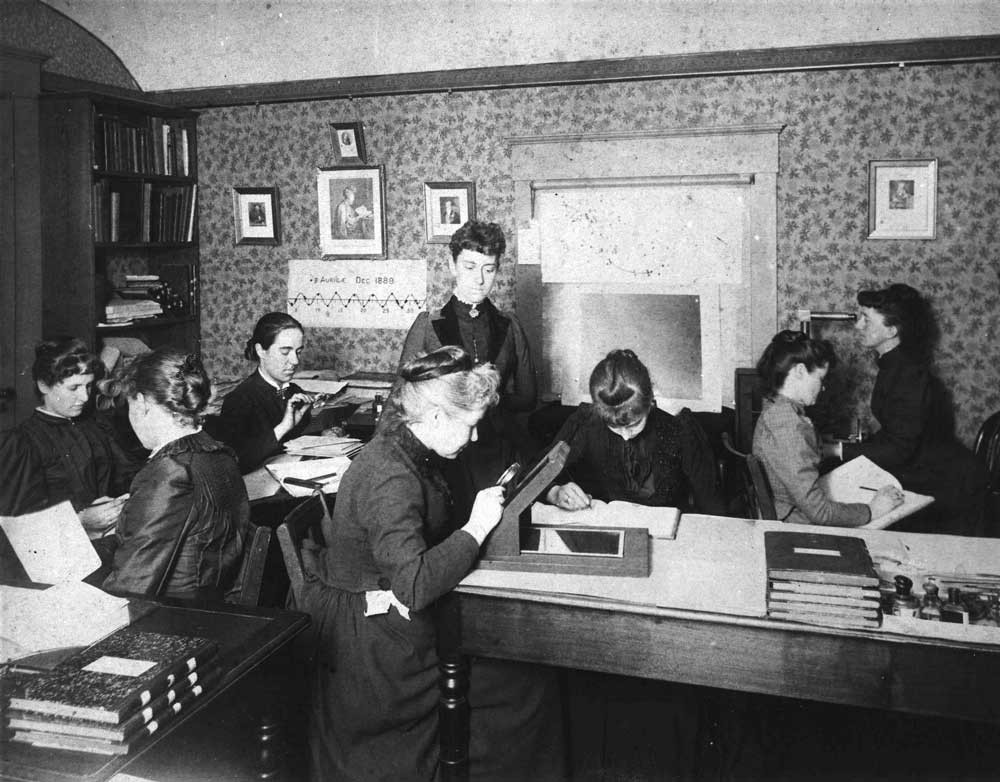
- [1] Body & Society 1:3-4, London: Sage, 1995, pp 45-64; repr. in Cyberspace, Cyberbodies, Cyberpunk, eds. Mike Featherstone and Roger Burrows, London: Sage, 1995. (P.46) read here
- [2] Plant, Sadie, The Future Looms: Weaving Women and Cybernetics (P.46)
- [3] Sophie Rentien Lando, Computers at Work – About Women in Computing, Paris: Espace Ness 2019, p. 5, 6
z
2Ada Lovelace
Ada Lovelace was born as Augusta Ada Byron in 1815 in London. She was the only legitimate child of of Lord George Byron (who was a poet, known for his great influence in romanticism) and Lady Anne Byron. Through her tutor Mary Somerville she was introduced to Charles Babbage, a mathematician, philosopher, inventor and mechanical engineer, to whom she developed a close relationship to. Often she would visit him to look at the Difference Engine (calculates, but simply adds numbers) Babbage was developing.
Soon Charles Babbage wanted to go one step further and together with Ada engaged in the possibility of making machinery to compute arithmetical tables.
Lovelace translated and commented the Italian mathematician Luigi Menabrea's article on Babbage's newest proposed machine, the Analytical Engine [1].
Ada Lovelace's notes were labelled alphabetically from A to G. In note G, she describes an algorithm for the Analytical Engine to compute Bernoulli numbers, this is later considered to be the first published algorithm
Ada Lovelace's work on the Analytical Engine (Science of operations) has more than an immediate influence, since no fitting hardware existed when Engine was developed.
Just as Joseph-Marie Jacquard’s silk-weaving machine could automatically create images using a chain of punched cards, so too could Babbage’s system—the engine, Lovelace explained, weaved algebraic patterns [2].
From her childhood on Ada Lovelace was Ill, suffering from illegible symptoms that were categorized as hysteria. She died in 1852 at only 36 years from what is now considered as cancer.
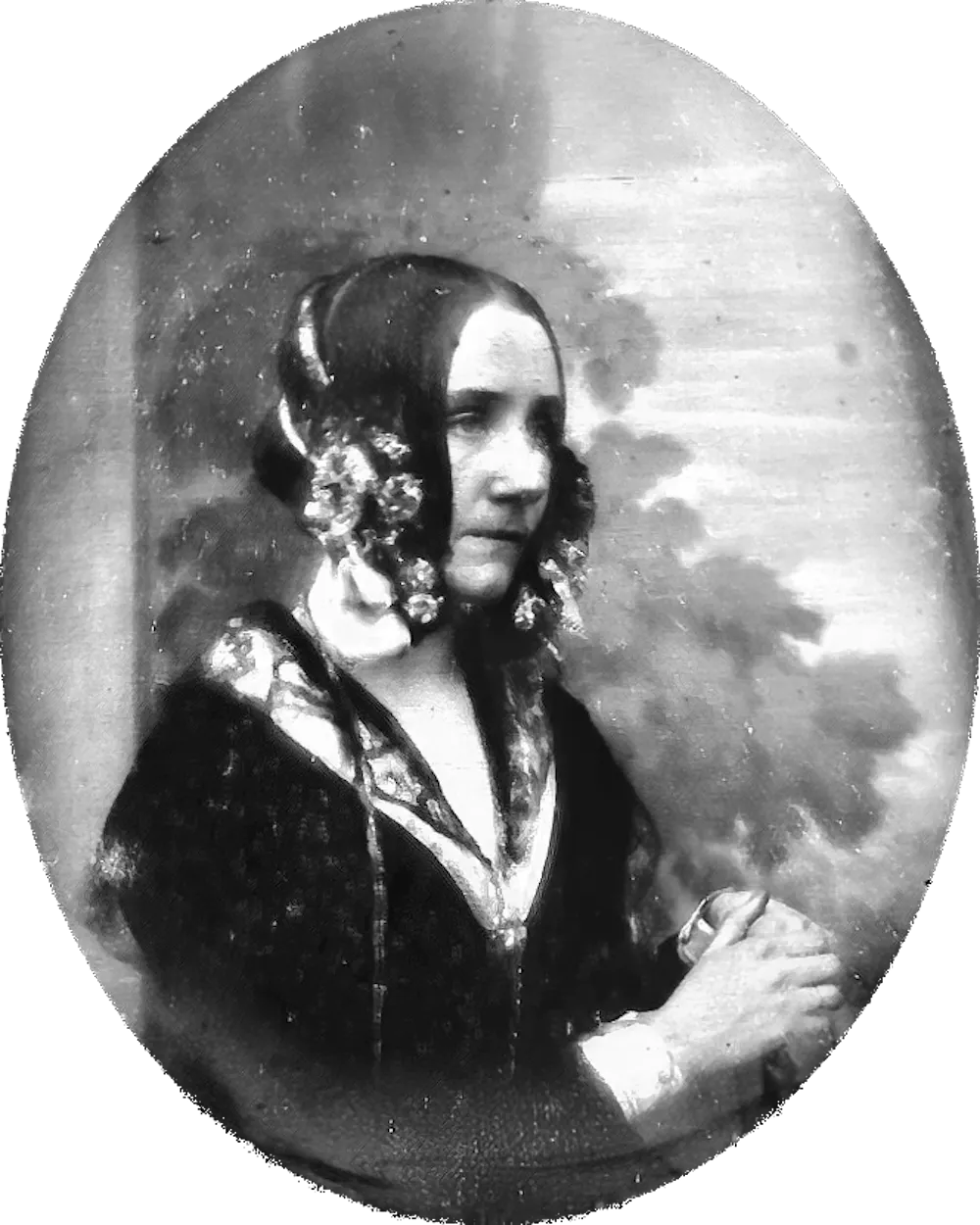

- [1] Huskey, Velma R.; Huskey, Harry D. (1980). "Lady Lovelace and Charles Babbage". Annals of the History of Computing. 2 (4): 299–329.
- [2] Ada Lovelace, the First Tech Visionary, by Betsy Morais, October 15, 2013, The New Yorker read here
z
2‚1 Footnotes
Hypertext Programs and the net are webs of footnotes without central points organizing principles and hierarchies [1].
While translating, Ada wrote her footnotes to Menabrea’s text, that in the end were three times as long as the text itself. Her work was implicitly supposed to be reinforcing these hierarchical divisions between centers and margins, authors and scribes. Menabrea’s memoir was the leading article; Ada’s work was merely a compilation of supporting detail, secondary commentary, material intended to back the author up, but appeared to be much more than that.
The frontiers of a book are never clear-cut: beyond the tide, the first lines, and the last full stop, beyond its internal configuration and its autonomous form, it is caught up in a system of references to other books, other texts, other sentences: it is a node within network [2].
Footnotes and the writing in the margins, of what is known as the "main or leading text", questions of lateral or upward citation, visual and content wise hierarchies arise. Mostly encountered today through autotheory as feminist practice in art, writing and criticism [3], we will blow the margins and open up the space for new relationalities.
One never writes alone. As Deleuze and Guattari say, one writing alone is already a crowd. Our words in this book are never without the echoes of the voices of those whose difference we chose to write with. Not to mention the moves, gestures, colors, architectures, and events of the creative practices we encountered. A veritable cacophony. Or better: an ecology [4].

- [1] Plant, Sadie. Zeros and Ones, Digital Women and the new Technoculture, 1997, P. 10
- [2] Michael Foucault
- [3] Lauren Fournier: Autotheory as feminist pratice in art, writing and criticism, 2021
- [4] Erin Manning & Brian Massumi, Thought in the Act (via bergmans-ghost)
- [5] excerpt from "A Lovers Discourse" by Roland Bartes, 1977, was one of the first books that depicted writing relationalities in a more engaging way.
z
3 zeros and ones
Women can, it seems, only imitate Nature, duplicate what nature offers and produces. In a kind of technical assistance and substitution [1].
All digital computers translate information into the zeros and ones of machine code. These binary digits are known as hits and strung together in bytes of eight.
This system refers to ancient logical codes, that make differences between on and off, left and right, light and dark. They are also called binary codes.
The system of notation and calculation we have today emerged from Hindu & arabic arithmetic, and was introduced by arabic scholars and asian traders.
Numbers in this system have two functions: Cardinal & Ordinal, which means they are expressing their place in a string and at the same time, their own specific value.
The introduction of the digits from zero to nine in (West-) Europe happend slowly starting during late Renaissance.
She has only a hole where the male has his source of creativity [2].
This logic is not new: in ancient Greece the number one stood for everything, the first, the best, good, the universal. First introduced in (western) European cultures, the church wanted to keep zero out of the numerical system. They liked the number One: one god, one truth, one way, Zero, back then, was unthinkable, connceted to the devil and hell. Later scientific research has shown us that holes are not absence of positive things. They rather are charged particles running in reverse, holes are not absence of particles but exactly them traveling faster than the speed of light.
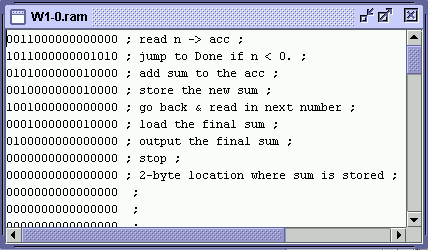
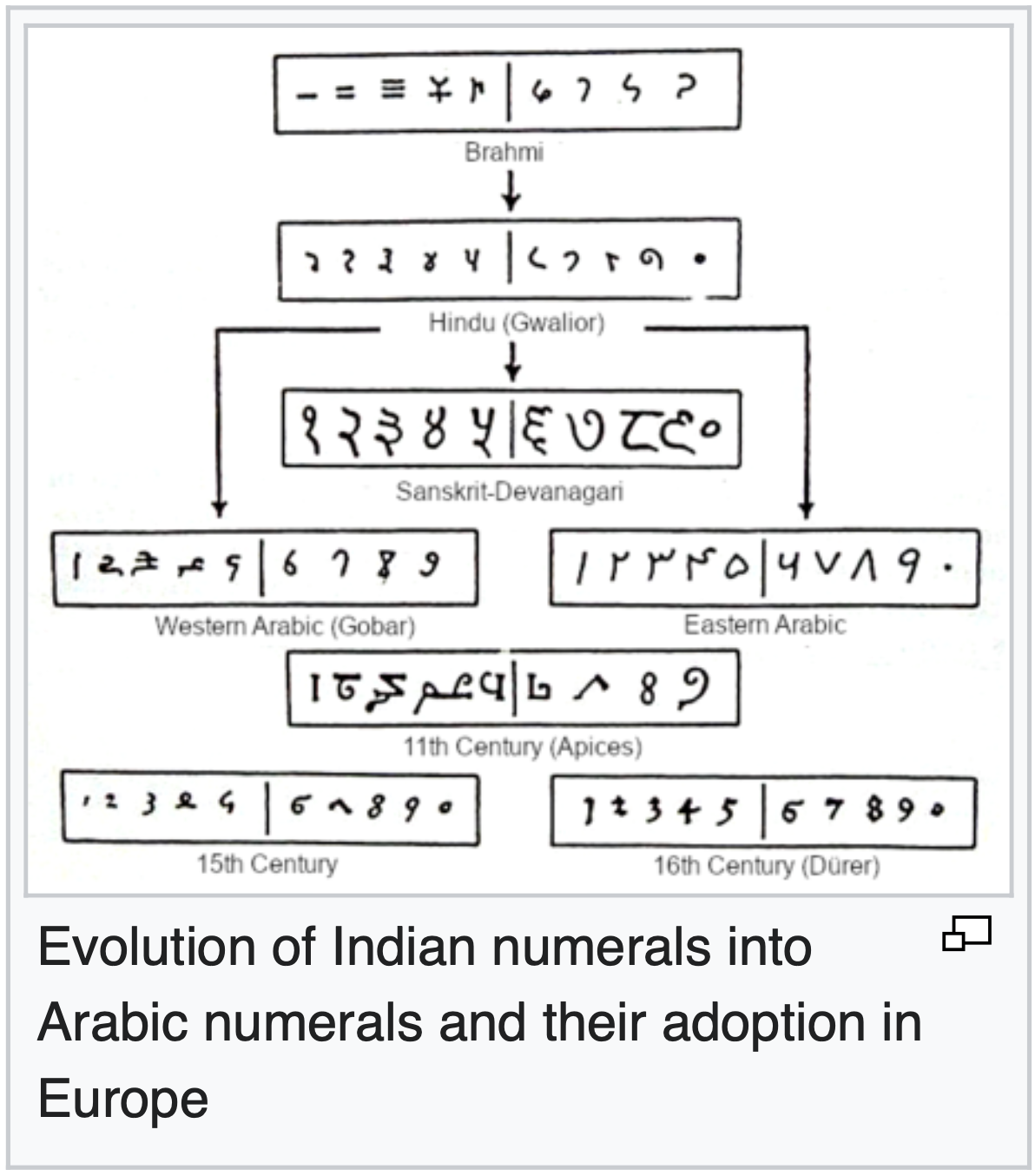
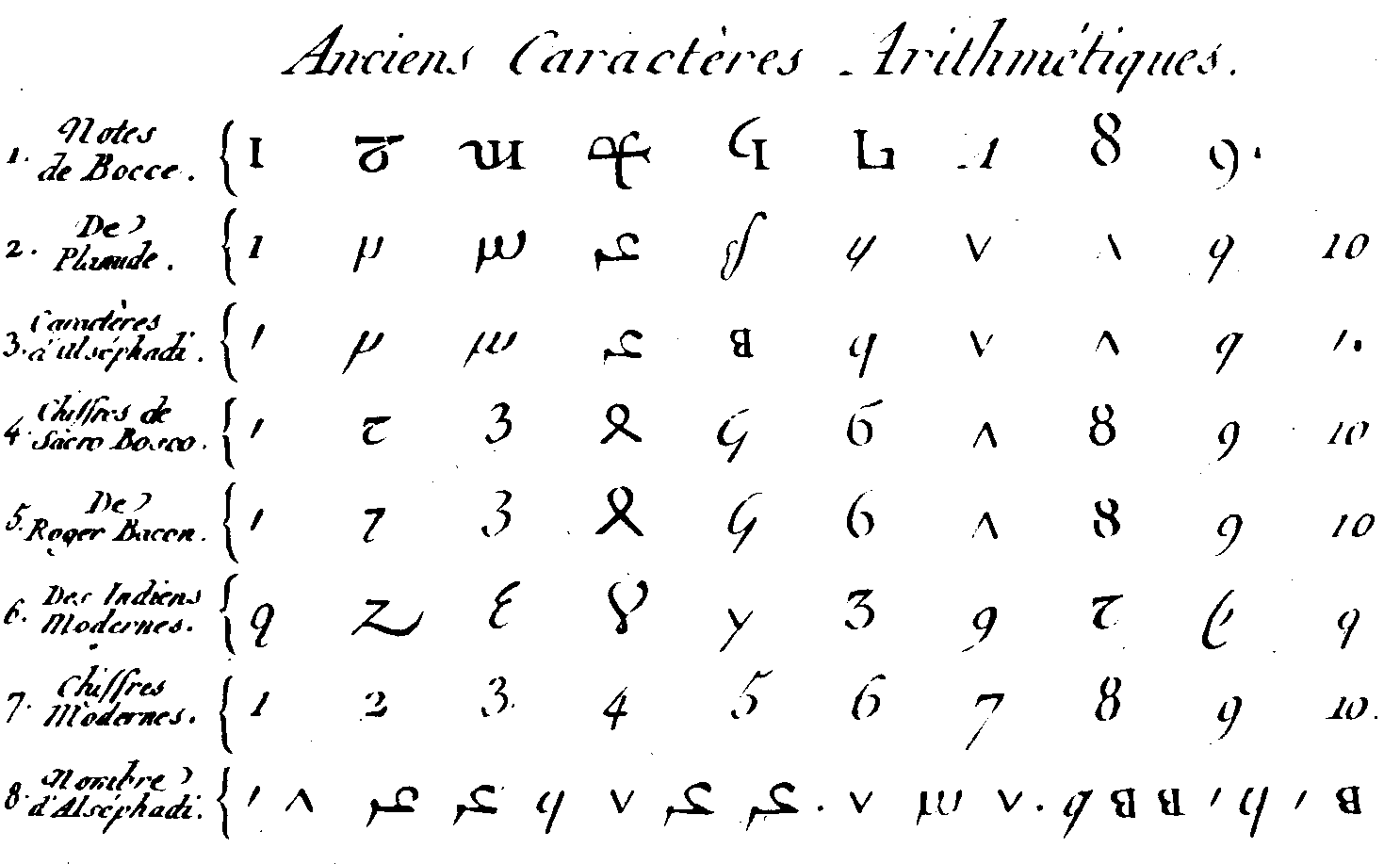
- [1] Plant, Sadie. Zeros and Ones, Digital Women and the new Technoculture, 1997, P. 24 from Sigmund Freud, “Femininity,”: in Sigmund Freud, New Introductory Lectures on Psychoanalysis, pp. 145- 69.
- [2] ibid.
z
3‚1 frankenstein
Though Frankenstein is infused with elements of the Gothic novel and the Romantic movement, scolars have argued for regarding it as the first true science-fiction story [1].
“Many and long were the conversations between Lord Byron and Percy Shelley, to which I was a devout but nearly silent listener” Mary Shelley wrote into her diary. She and her future husband are visting Lord Byron in his residence in switzerland during summer 1816. Since it was the Year Without a Summer, they read and wrote horror stories for their amusement. Mary Shelley dreamt of one by night and couldn't forget about it by day. Soon she started to write it down and what was started to become a short story resulted in a novel. It was published in 1818 anonymously, and first everyone claimed it her husbands work first. Frankenstein; or, The Modern Prometheus became a quintessential story of man and machine [2].

- [1] Clute, John; Nicholls, Peter (1993). "Mary W. Shelley". Encyclopedia of Science Fiction. Orbit/Time Warner Book Group UK. Archived from the original on 16 November 2006. Retrieved 17 January 2007.
- [2] Plant, Sadie. Zeros and Ones, Digital Women and the new Technoculture, 1997, P. 102
z
4Virtual Aliens
Hardware, Software, Wetware–Women have been the Simulators, assemblers and programmers of the digital machines [1], so called "Virtual Aliens".
When computers changed, became miniaturized circuits of silicon chips instead of roomsized machines, it were [again] women who assembled them. Similar swifts can also be seen in the developement of office technology: when typewriters, duplicators, switching systems, calculators, computers came, men found themself replaced by network of women and machines. The majority of electronics assembly jobs are and have been occupied by young female workers, who work for lower wages and often worse and dangerous conditions than men. Those virtual aliens are just the most recent developement in
the long and twisted line of microprocesses which emerge from a tangle of telephonelines, dials, operators, cables, tones, switches, and plugs; the keys, carriages, and cases of typewriters; the punched-card programs of calculators, pianolas, and looms; flying shuttles, spinning wheels [2].
The conditions and types of work draw clear parallel lines to the (modern) textile and clothing industry. (See Chapter 1 on Weaving)
Let me tie at least one of many loose ends here. You may rightfully wonder: what happened to women programmers? Why is the image we have of a programmer today automatically, reflexively, that of a man? [3]
Cables essentially shape and enable such processes [of communication flows and information distribution]. They represent a dispositiv, an infrastructure for technologies of any kind; they are the media of the media [4].
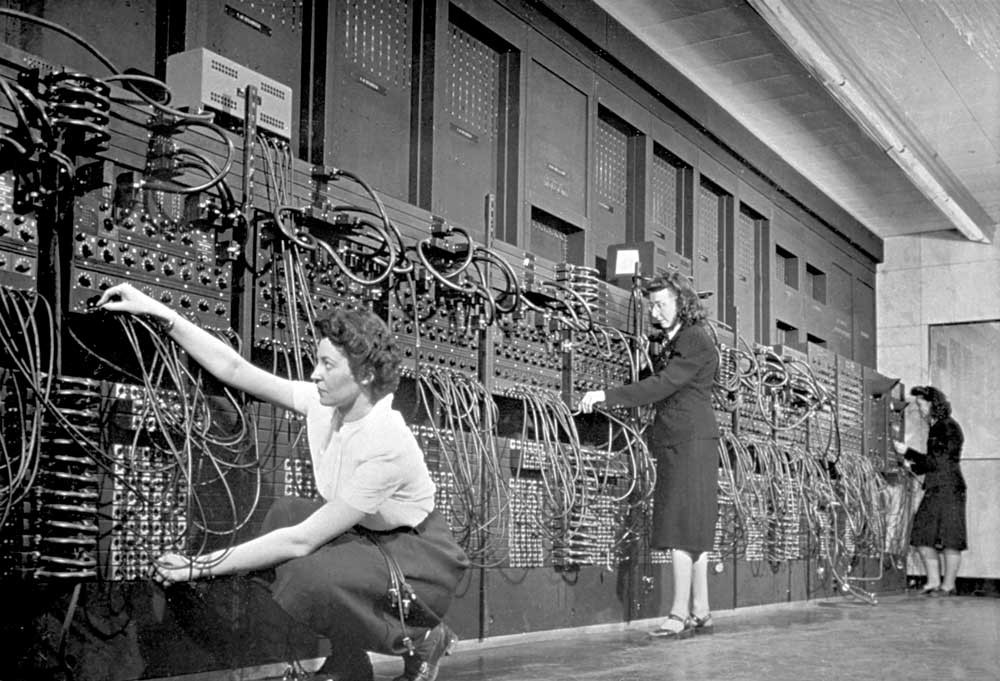
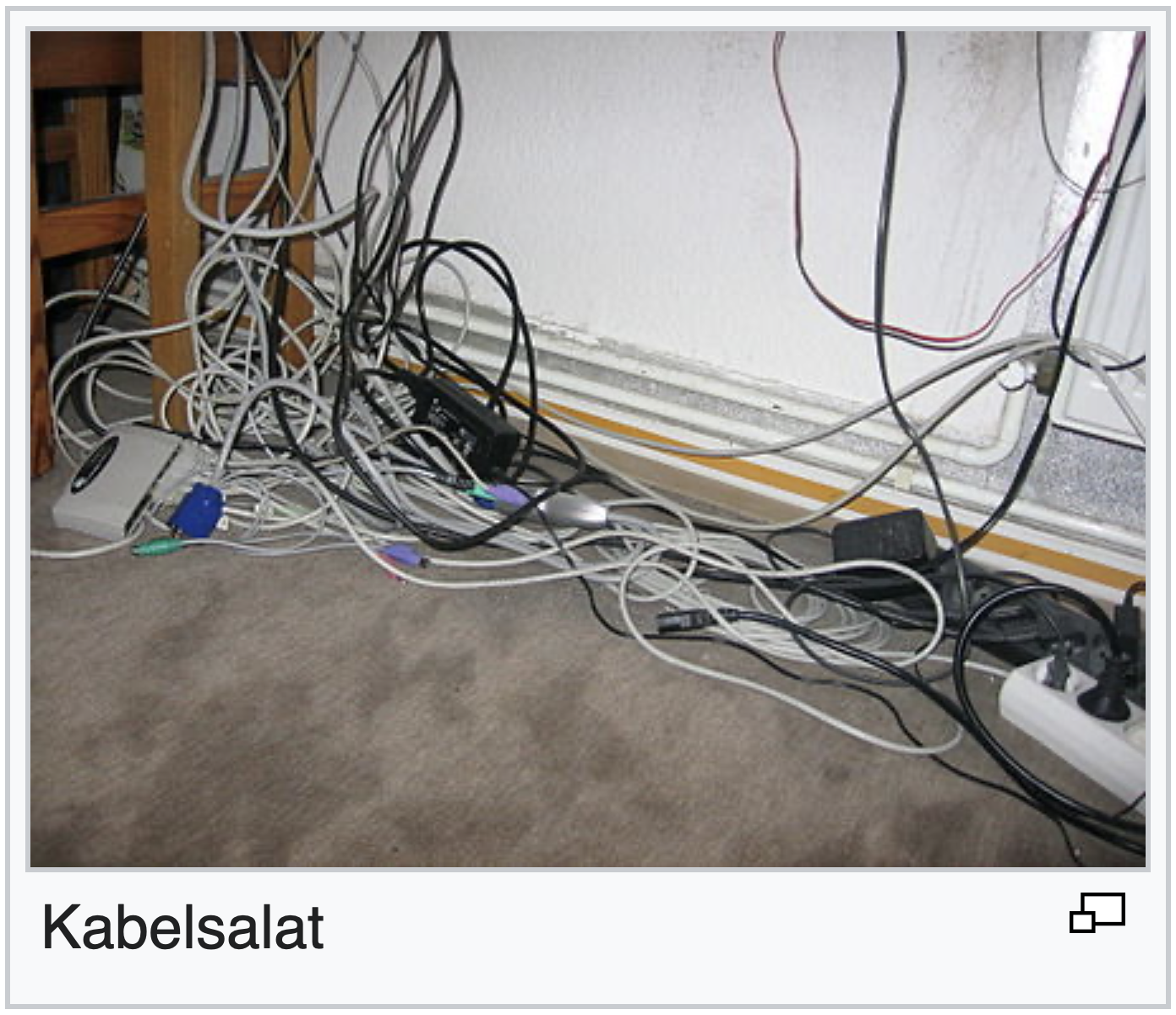
- [1] Plant, Sadie. Zeros and Ones, Digital Women and the new Technoculture, 1997, P. 37
- [2] ibid.
- [3] Code, Text, Type, Anna Cairns, 2022, https://c0da.org/contributions/code-text-type
- [4] Gethmann & Sprenger, 2014: p. 115
z
5 Grace Muriel Hopper
Grace Hopper. Many women, in nylon stockings, kissing to celebrate D-Day. Their job was to plug in the cables; they were in charge of insertion, penetration. A masculinised harem of mathematically gifted doms, puellae doctae, declares: command and control [1].
Grace Murray Hopper is thought of as the second first computer programer. She worked with the Automatic sequence controlled calculator, which she called my Monster. After multiple graduations and PhD in Mathematics in Yale she worked in the US navy most her lifetime.
Grace Hopper's husband was Vincent, a professor of literature. [...] For her, it was more important for the computer to understand the language of the programmer than for the programmer to understand the language of the computer. So she too had a feel for language. She asked her own mathematics students to write essays which she assessed on criteria of clarity and style [2].
Grace Hopper was the first one to develop and code in a language understandable for humans instead of just zeros and ones, which are understood by machines. The first of such data processing languages was called Flow-Matic (1955). It had around 30 commands like COMPARE, DIVIDE, IF GREATER, OTHERWISE and was mostly used for economic and trading purposes. Flow-Matic built the framework for the later COBOL "common business-oriented language“ (1959).
The term debugging is also traced back to Hoppers work, which is only half correct, it wasn’t the software that caused an error, but a moth in her computer hardware. Bug as a term for a mistake or problem was already used in the century before in engineering work, but got popular in computation after the moth incident.
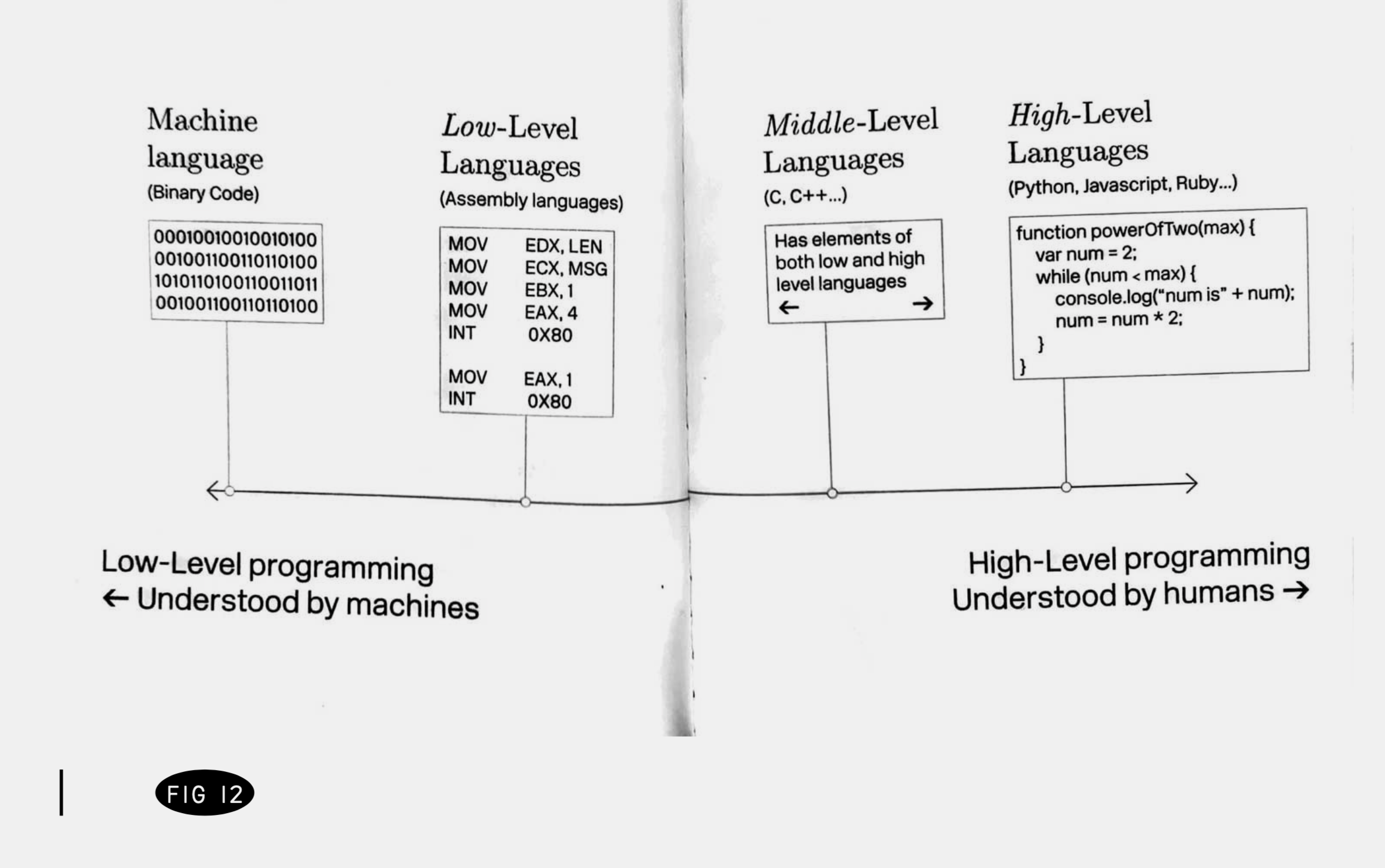
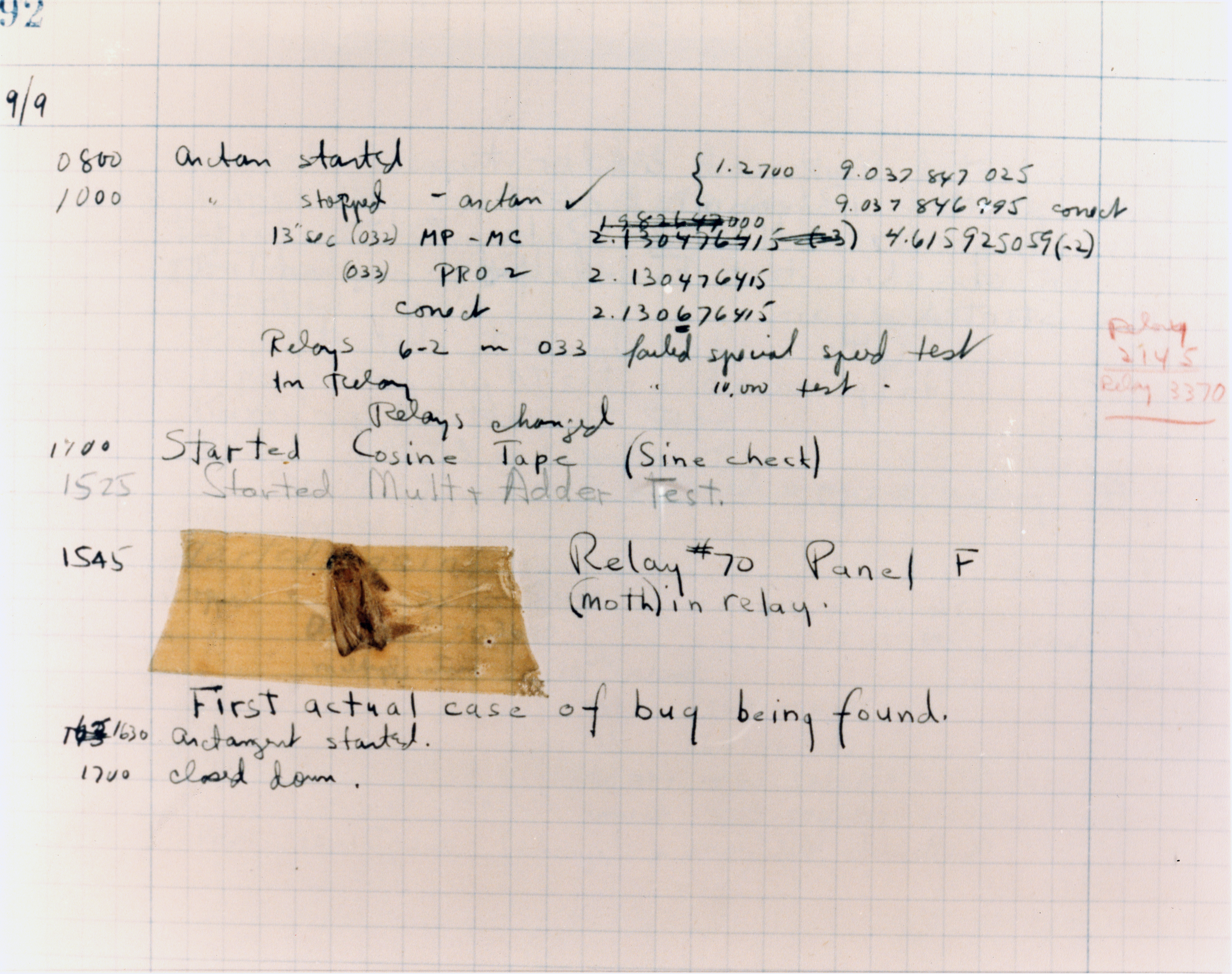
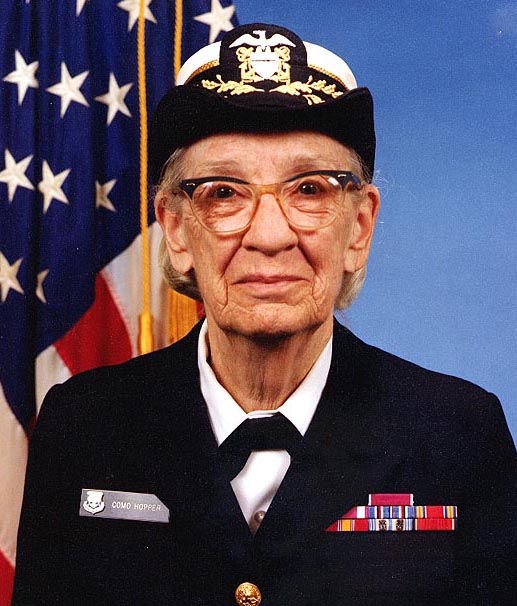
- [1] Software warfare: EX PONTO BITCHES, Sophia Eisenhut translated by Sadie Plant, Coda, 2022, https://c0da.org/contributions/software-warfare-ex-ponto-bitches-2
- [2] ibid.
z
5‚1 Margaret Hamilton
Margaret Hamilton worked on several projects at the MIT in 1959 in Boston, where she programmed her first softwares for the weather and later the air-force department. She soon after Hamilton was the first hired programmer for the apollo lunar exploration program by NASA and in 1965 she was made director of her software engineering division. Margaret Hamilton started using the term software engineering during the early Apollo missions [1], software development was not taken seriously compared to other engineering [2], nor was it regarded as a science.
When I first came up with the term, no one had heard of it before, at least in our world. It was an ongoing joke for a long time. They liked to kid me about my radical ideas. It was a memorable day when one of the most respected hardware gurus explained to everyone in a meeting that he agreed with me that the process of building software should also be considered an engineering discipline, just like with hardware. Not because of his acceptance of the new 'term' per se, but because we had earned his and the acceptance of the others in the room as being in an engineering field in its own right [3].
Margaret Hamilton not only co-developed the core principles of computer programming in writing code for the first portable computer [4], her innovations played important roles in getting humans to the moon.
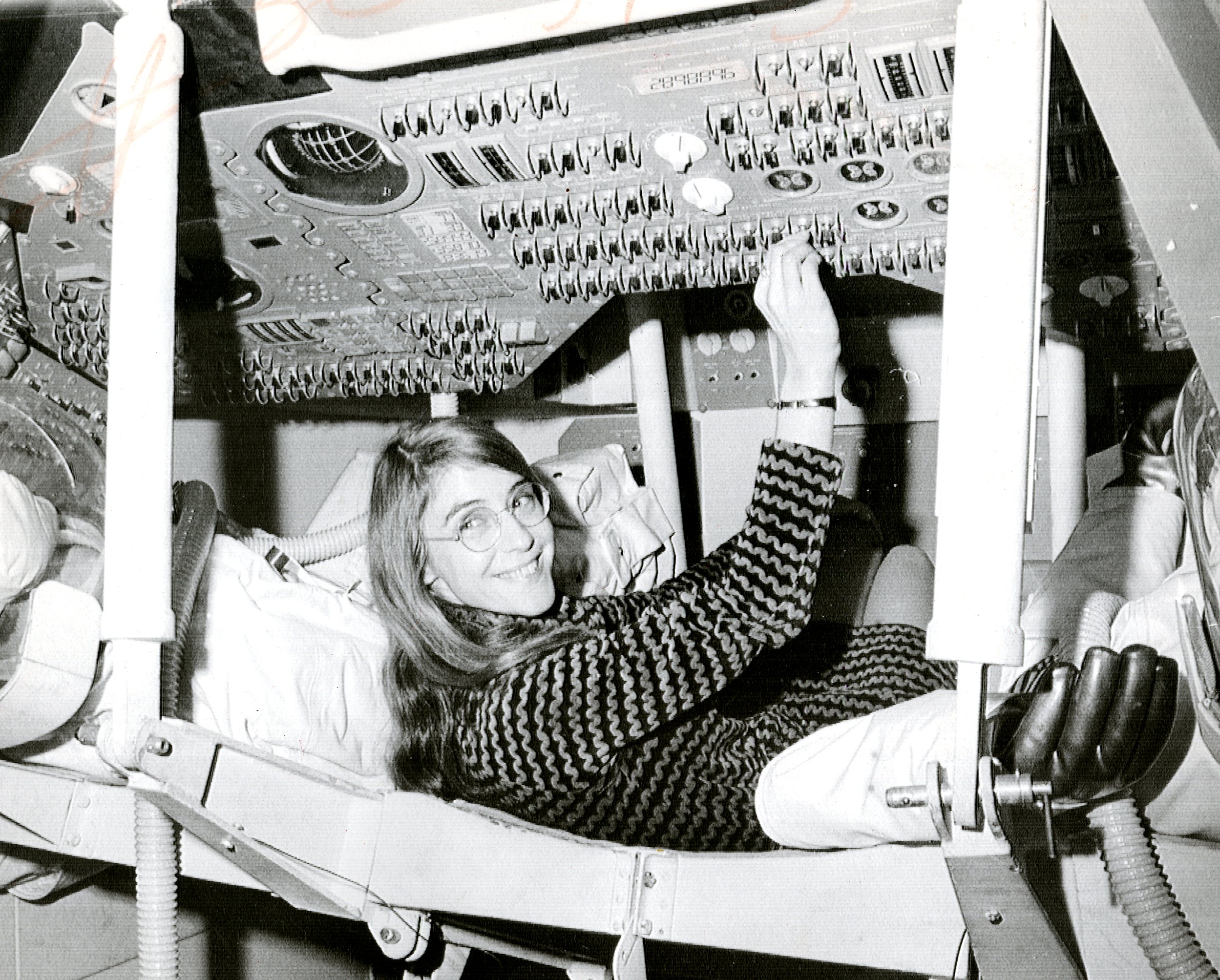
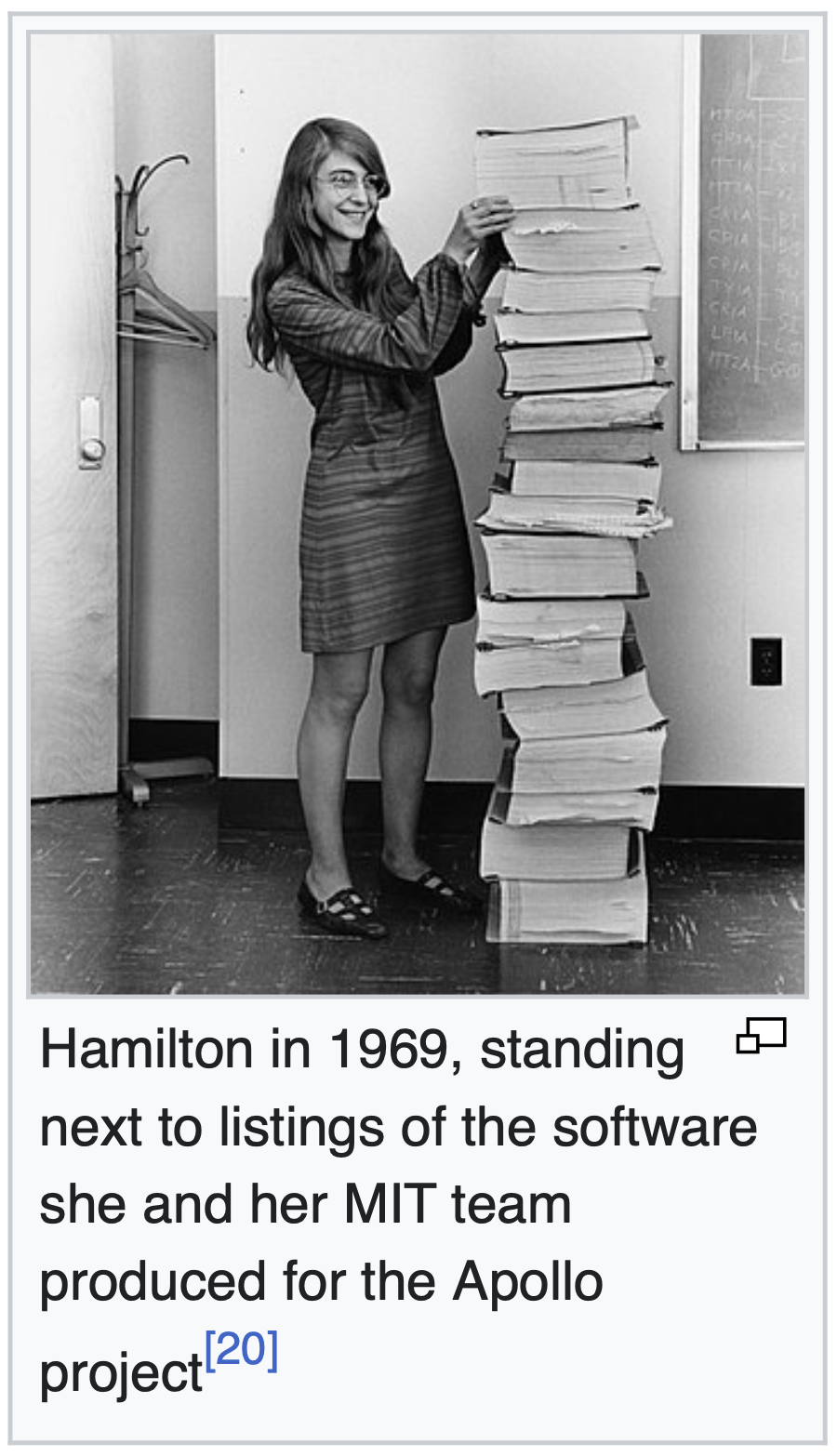
- [1] Rayl, A.J.S. (October 16, 2008). "NASA Engineers and Scientists-Transforming Dreams Into Reality". 50th Magazine. NASA. Archived from the original on December 23, 2014. Retrieved December 27, 2014.
- [2] Makers:Margaret Hamilton Videos". Makers.com. Archived from the original on September 5, 2017. Retrieved September 5, 2017.
- [3] Snyder, Lawrence and Henry, Ray Laura, "Fluency7 with Information Technology", Pearson, ISBN 0-13-444872-3
- [4] McMillan, Robert (October 13, 2015). "Her code got humans on the moon – and invented software itself". Wired. Archived from the original on October 23, 2015. Retrieved October 20, 2015.
- [5] Weinstock, Maia (August 17, 2016). "Scene at MIT: Margaret Hamilton's Apollo code". MIT News. Archived from the original on August 18, 2016. Retrieved August 17, 2016.
z
6Cyberfeminism
The new technological possibilities opened up different spacial dimensions and relations: parallel emergence, noncausal connections and simultaneous developments [1] shifted perspectives on society, sexuality and identity. As personal computers and cyberpunk narratives numbers exploded in the mid 1980ies and Donna Haraway’s cyborgs were writing manifestos of their own.
“Bv the late twentieth century,” they declared, “our time, a mythic time, we are all chimeras, theorized and fabricated hybrids of machine and or- ganism; in short, we are all cyborgs.” [2]
VNS Matrix cyberfeminist media art collective formed in Adelaide:
The Clitoris is a direct line to the matrix is what they put on a billboard in 1991. The sentence is an excerpt from their Cyberfeminist Manifesto for the 21st Century. It's line refers both, to womb (matrix is latin term for greek hysteria) and abstract networks of communication.
They say that they are starting from zero. They say that a new world is beginning. They say, if machines, even the machines of theory, can arouse themselves, why not women? [3]
[Women] have functioned as an ‘infrastructure’ unrecognized as such by our society and our culture [4].

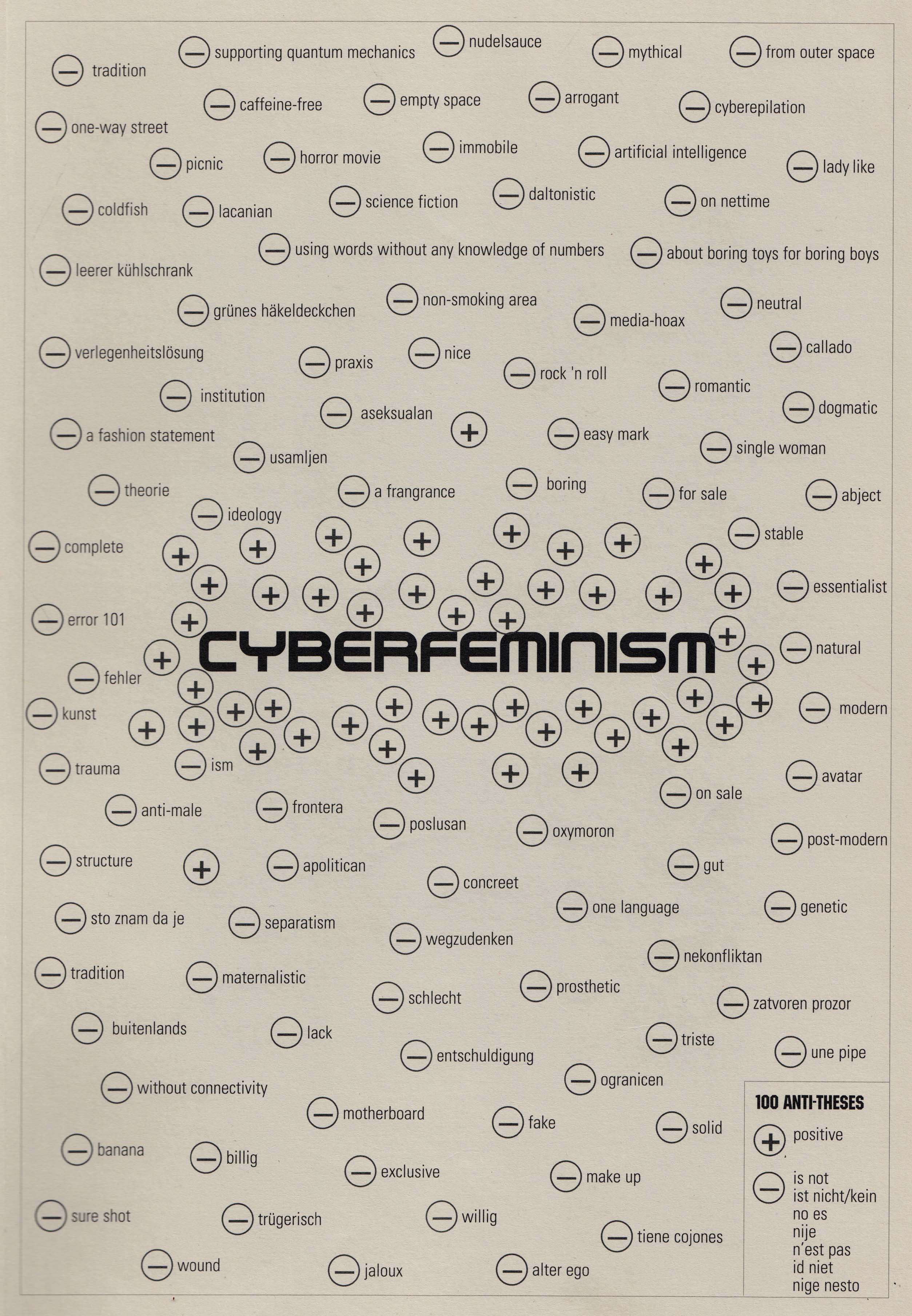
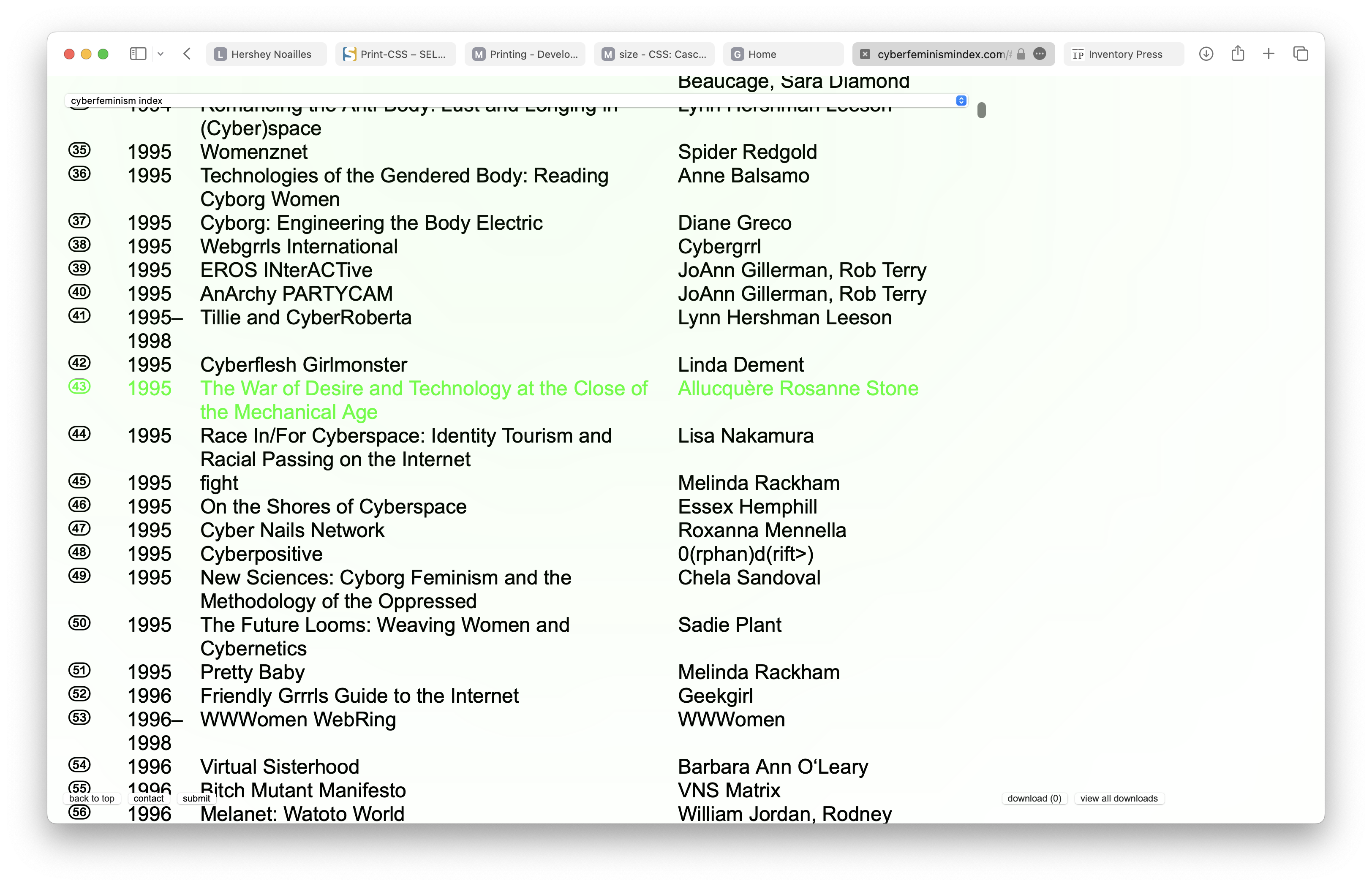
- [1] Plant, Sadie. Zeros and Ones, Digital Women and the new Technoculture, 1997, P. 58
- [2] Donna Haraway, “A Cyborg Manifesto: Science, Technology, and Socialist-Feminism in the Late Twentieth Century,” p. 150.
- [3] Luce Irigaray, Speculum of the Other Woman, p. 232. in Plant, Sadie. Zeros and Ones, Digital Women and the new Technoculture, 1997, P. 58
- [4] Luce Irigaray, This Sex Which Is Not One, p. 84.
z
7 World Wide Web
The underlined Hyperlink: The history of underlining text dates back to the Romans, who used the vinculum (in the form of both under- and over-lining) to distinguish Roman numerals from letters in running text. Later, especially into the Middle Ages, the vinculum was used to indicate numeral multiplication. Unlike other forms of highlighting, underlining is quite easy and can be performed on different media with any writing instrument. The underline continues to be used for notation and emphasis by book readers and was adopted in areas related to hyperlink-like media, including in library science, where words were underlined to indicate the word by which a book was filed.
Technological influences:
The underline came into its own as a cultural force with the invention of the typewriter. Since typewriters contain only a single font, variants such as italics, bold and other techniques were not available, so the underline was used for many purposes. On a typewriter, creating an underline was just a matter of over-typing with an underscore, so it could be implemented easily without much modification to the machine.
The inherent limitations of using a typewriter-like device as the input/output device for a computer system shaped the development of early computer systems, and thus early hypertext systems [1].
Despite this variation in usage, there is a common thread: the underline is used to tie together pieces of writing. The underlining writer intends to signal to the reader that the text indicated is related in some way.
IMPOSSIBLE ON MAC, WINDOWS AND LINUX, When Xerox PARC released their first computer with a "modern" interface, the Alto, they did not offer visible connections between windows, though such connections would have been possible. But when the Alto was imitated by the Apple Macintosh and then Microsoft Windows, such connections became impossible. And needless to say, the further imitations of these windows on Linux don't make such connections possible either [2].

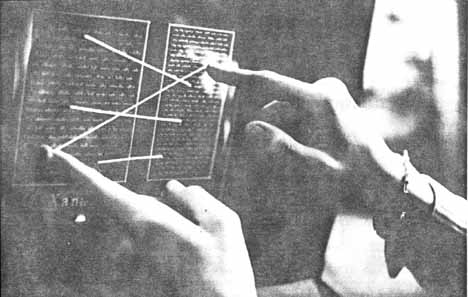

- [1]Romano, John J. 2016. The Origins of the Underline as Visual Representation of the Hyperlink on the Web: A Case Study in Skeuomorphism. Master's thesis, Harvard Extension School.
- [2] Alan Kay, personal communication, https://xanadu.com/xUniverse-D6
- [3] THE XANADU® PARALLEL UNIVERSE Visibly Connected Pages and Documents for a New Kind of Writing, Website and Documentation
z
8Codes
The Monospaced- matrix:
Monospaced fonts were widely used in early computers and computer terminals, which often had extremely limited graphical capabilities.
Hardware implementation was simplified by using a text mode where the screen layout was addressed as a regular grid of tiles, each of which could be set to display a character by indexing into the hardware's character map.
As memory was very little in the early days of computers and only a finite amount of metadata could be stored for each character without adding more memory, the monospaced characters appeared on most personal computers and with that shaped the apperance of terminals and coding interfaces until today.
Through the vertical lines at the beginning of a line of code, the codes nested structure is visualized. Similar patterns have been adopted in depicting (E-Mail) threads to contextualize conversations.
Lines have a way of accumulating the more we write, the deeper we dig and the longer we go. It means something is building: software, patterns, conversations, layers, story. These lines we can create ourselves; they make a structure that we can use to crawl in between hierarchies and chronologies; and they are the scaffold this website, this text, this story builds on [1].
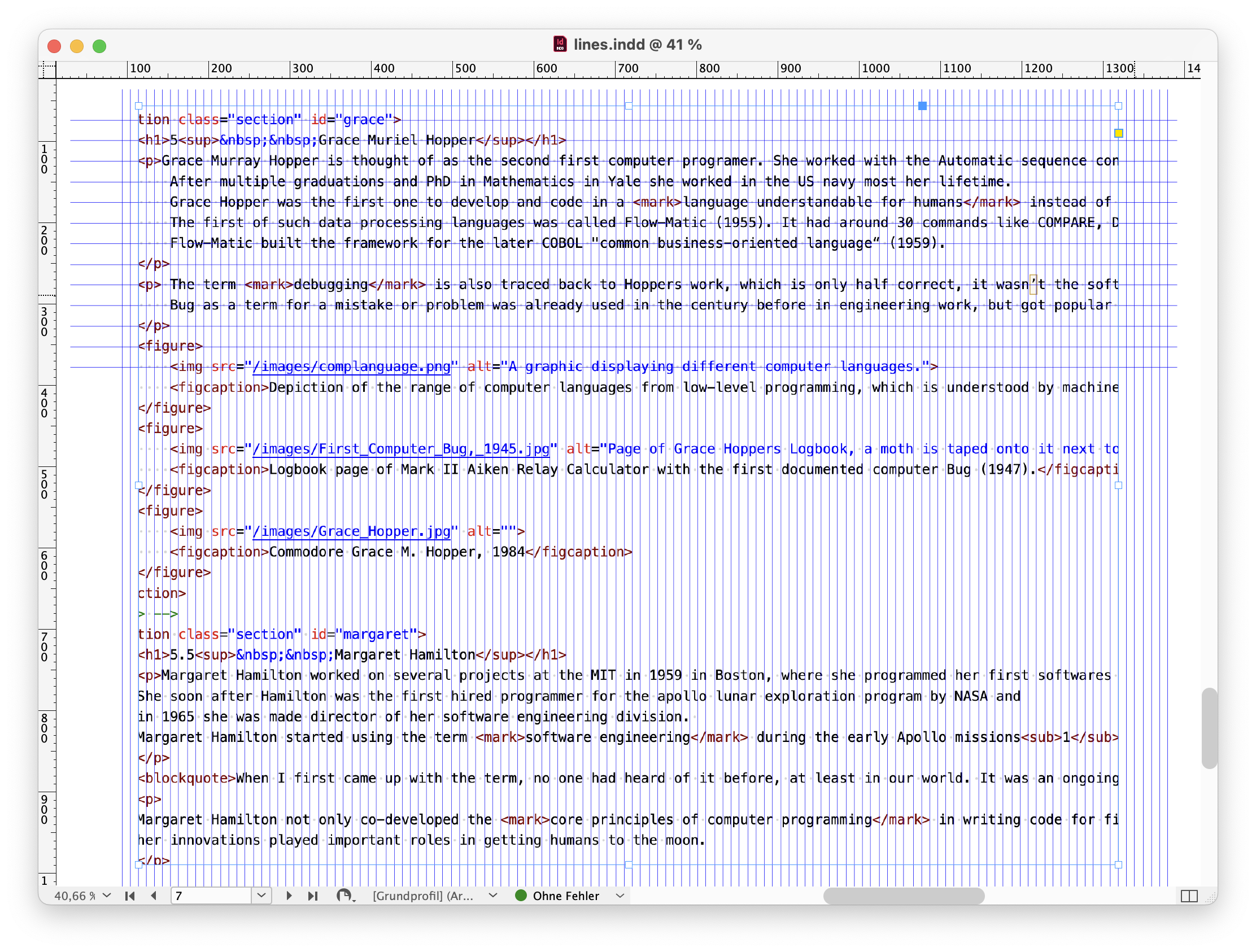
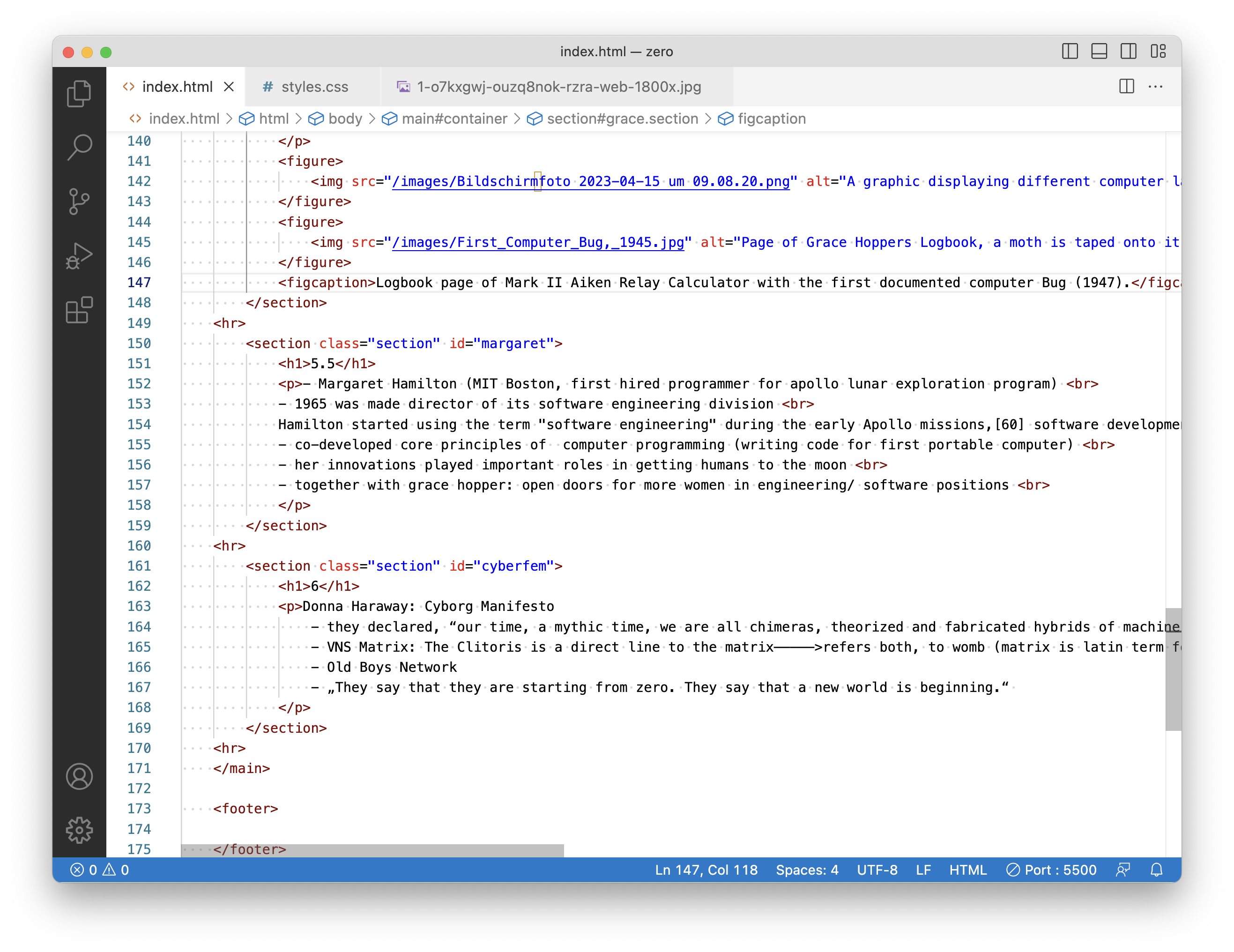
- [1] Cairns Anna, Code, Text, Type, 2022, https://c0da.org/contributions/code-text-type